The Gift of SAR
Story and photos by Skip Robinson
Safika partner company Trakka plays an important role in US rescue efforts.
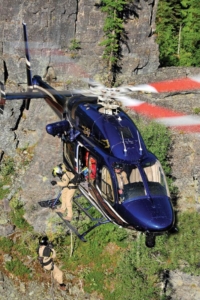
Technical high altitude hoist rescues are a large part of Two Bear Air’s operations. Here, its Bell 429 shows what it can do.
Flathead County, in Northwestern Montana, contains some of the most ruggedly beautiful land in the United States. More than 94 percent of its over 5,000 square miles are national or state forest land, wilderness, or used for agriculture or timber, and its soaring mountain ranges and expansive lakes create a natural playground and are an irresistible draw to residents and visitors alike.
But what makes the county particularly special is the unique form of aviation support it receives, in the form of Two Bear Air. The operation has been providing lifesaving search-and-rescue (SAR) services, as well as flying law enforcement missions, since its launch just two years ago. For those living in or visiting the region, the mere fact that there’s a SAR aviation unit at all is something for which they’re hugely thankful. And the fact that it’s operating a brand new hoist-equipped Bell 429, as well as an MD 500E, would make it the envy of many SAR aviation units around the country. But for an outsider, the most noteworthy aspect is how the service is funded — at no cost whatsoever to the taxpayer. And those who are rescued never have to pay a cent. All costs for the operation, from the acquisition of the aircraft to the associated training for the aircrews and maintenance, are covered by local philanthropist Mike Goguen. Thus far, Goguen has spent well over $10 million on Two Bear Air — his gift to the people of Flathead County.
The program’s origins can be traced back to former Flathead County Undersheriff (now Deputy Sheriff) Jordan White’s efforts, in September 2011, to raise funds for SAR equipment to enhance the region’s capabilities. Goguen learned that there was a need for a hoist-equipped SAR helicopter (ALERT Air Ambulance serves the region with a Bell 407, but it doesn’t have a hoist), and Two Bear Air was quickly created. The initial crew consisted of White (who was appointed executive director of the operation), chief pilot Jim Pierce, and Flathead County Sheriff Chuck Curry. White and Curry were designated to be trained as the rescue flight crew. With a Bell 429 on order, Two Bear began operations with a Bell 407 in August 2012.
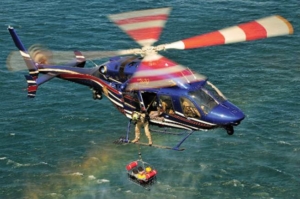
With many lakes and rivers in the region it supports, Two Bear needs to be prepared to conduct rescues over water.
The range of missions Two Bear flies is as vast as Montana itself. In addition to its SAR work, it conducts a broad range of law enforcement operations for local, federal, and state agencies, and its missions have taken it across Montana and into Idaho. The helicopters, operated as public use aircraft, are flown under the authority of the Flathead County Sheriff’s Office, which also provides the aircraft’s rear crewmembers. Two Bear also works in close partnership with Kalispell-based ALERT Air Ambulance.
“Many times ALERT will call Two Bear Air when a hoist rescue is required, and Two Bear Air will call ALERT when a medical response is required,” said White. “It’s a good relationship and helps everyone involved.”
The type of calls Two Bear responds to will vary according to the season. During summer months, hiking and climbing accidents are common, requiring technical hoist rescues at higher altitudes that tax the performance of the aircraft. Watersport accidents are also common, requiring the crew to train for water rescues with rescue swimmers. The winter brings more searches and less hoist work, with snowmobilers, skiers and hikers at risk of getting lost in bad weather. According to White, night operations in either season are never routine, and require an in-depth risk assessment before launch. “Everything around our base is very remote, so when we’re called out, it’s to very dark places,” he said. “That’s when our infared camera, NVGs [night vision goggles] and crew resource management comes into play — and we use them all.”
Choosing the Right Tools
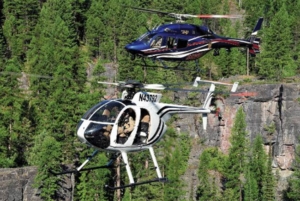
The combination of an MD 500E and a Bell 429 supports Two Bear’s mission profile perfectly.
Two Bear’s Bell 429 (designated “Air 1”) and MD 500E (“Air 2”) are based at Glacier International Airport in Kalispell, Mont. And while the organization always planned to add the 429 to its fleet, the 500E was brought in when Two Bear’s Bell 407 was damaged while servicing a remote radio repeater site. White said the decision to replace the 407 with the 500E — rather than another 407 — was a practical one. “We felt a 500E would suit us better. It’s a smaller, more economical helicopter with a footprint that allows us to get into tighter places,” he said.
The aircraft began operations in July 2013, and has a Garmin 500H glass cockpit, is fully NVG-compatible, and has an extended range tank. Due to Two Bear’s desire to keep the aircraft as light as possible, the 500E does not have an infrared camera or searchlight. It’s considered the operation’s “worker bee,” and is routinely used to lift equipment and conduct searches, or for missions where the 429 is considered more than the organization needs. “We recognized early on that having a backup or support aircraft would save flight time on the Bell 429, and having two aircraft allows us to conduct multiple missions simultaneously, which is not uncommon,” said White. “Because of its size and rotor diameter, the 500E is a great aircraft for searches. It’s able to get into riverbeds and tight canyons, and do ‘toe-ins’ and ‘one-skids’ during insertions.”
The 429 was delivered in October 2013, and crews soon began hoist training with Priority 1 Air Rescue, based in Mesa, Ariz. “Once Mike Goguen made a commitment to this, [we] started looking for a company able to develop and train the flight crews,” said White. “Priority 1 rose to the top on the list and showed it had a training strategy to get Two Bear Air in operation quickly.”
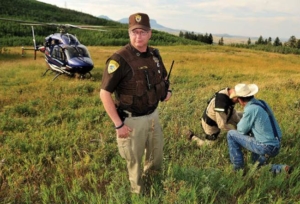
Checking out a rancher after a search mission. With Two Bear lending a helping hand, local law enforcement agencies now have the air support they once could have only dreamed of.
The training of the first crew was conducted over two intense weeks, with additional crews taking part in subsequent sessions in Kalispell. The initial crew then completed an advanced training curriculum, allowing them to perform night hoists, high-angle and swift water rescues, hoisting to vessels, and rescue swimmer deployment.
According to White, Two Bear also looked at the MD 902, Airbus Helicopters EC145, and the AgustaWestland AW109 during its initial research. “The 429 had new technology engines, a very smooth rotor system and a spacious and usable rear cabin,” said White. “We also liked the cockpit and its avionics package. . . . and it hasn’t let us down.”
Pierce, the 429’s primary pilot, said the aircraft’s power was impressive. “It exceeds the charted performance at our airport and up to altitude,” he said. “We perform missions up to 10,000 feet AMSL [above mean sea level] without any problem, even during the summer months.”
In particular, Pierce praised the 429’s smoothness, its lateral stability during hoist missions, and its tail rotor authority. “If a rescue requires hovering with a tailwind, there is plenty of control, and it flies without vibration up to its max airspeed,” he said. “The only issue we have had is the tail rotor pitch links wearing out too fast. Bell is working on a solution, and the last set seems quite a bit better.”
The 429’s cockpit is fully NVG-compatible, with night vision configuration completed by Bell, and goggles and training provided by Aviation Specialties Unlimited.
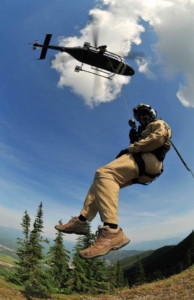
Mountain hoisting can take place over 10,000 feet, but normal operation occurs between 4,000 to 8,000 feet.
The aircraft is equipped with an Aerocomputers 3D- mapping system, Avalex monitors and video recorder, a TrakkaBeam searchlight, and an L3 Wescam MX-10 camera system. “The IR [infrared] camera is really nice with excellent picture quality,” said Pierce. “We find the reference points unbeatable — we use the IR from -30 F to 100 F and the contrast and clarity is amazing.”
Two Bear uses a Goodrich high-speed hoist on the 429, and Pierce said it works well and maintenance is low. Along with standard survival gear, other rescue equipment carried on the aircraft includes a collapsible rescue basket, a collapsible litter, a screamer suit, a plastic backboard, a pep bag and rescue strops — with the majority supplied by Priority 1. The crew also carries sidearms and rifles if needed, as coming across a bear is not unheard of.
Looking ahead
Following an intense year of development at Two Bear, the next 12 months will see the organization continue to refine its operations, while expanding its relationships with nearby jurisdictions in both Montana and Idaho.
“We travel and do presentations on our capabilities with anyone who asks,” said Pierce. “Our philosophy is using the resources we have to help save lives.” In this vein, Two Bear is currently working with the Glacier National Park and the US Forest Service to establish hoist insertion training programs for their staff. Further training in high-angle and swift water rescues is planned, and the organization’s crew continues to expand, with four new rear crewmembers recently joining.
“When Two Bear Air was being developed, no one could have guessed there would be over 100 missions in the first year with the 429,” said White. “We have the proper aircraft for the mission, we have highly motivated and focused crews, and our plan is to continue to utilize these assets to provide the highest quality of care and support to our citizens.”
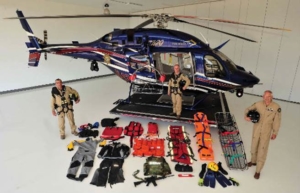
Having to operate in all conditions, the Bell 429 is fully equipped for both the law enforcement and rescue missions. Two Bear Air’s initial flight crew (from left): Sheriff Chuck Curry, Deputy Jordon White, and pilot Jim Pierce.
When Two Bear took delivery of the Bell 429, the man funding the entire operation, Mike Goguen, spoke modestly about the investment he was making on behalf of his community. “You can’t put a value on saving even one life,” he said. “Montana is a place where we help our neighbors, and I feel privileged to be able to give this gift to the Flat-head Valley community.” And with such an immediate and dramatic impact made in the 429’s first year in operation, the enduring value of the gift of Two Bear to those in Northwest Montana over the coming years will be truly immeasurable.

